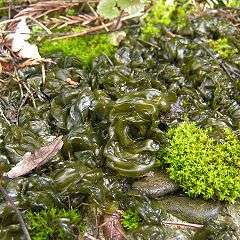Nostoc
| Nostoc | |
|---|---|
 | |
| N. commune | |
| Scientific classification | |
| Kingdom: | Bacteria |
| Phylum: | Cyanobacteria |
| Class: | see taxonomic note |
| Order: | Nostocales |
| Family: | Nostocaceae |
| Genus: | Nostoc |
| Species | |
|
N. azollae | |
Nostoc is a genus of cyanobacteria found in various environments that forms colonies composed of filaments of moniliform cells in a gelatinous sheath.
The name Nostoc was coined by Paracelsus.[1]
Nostoc can be found in soil, on moist rocks, at the bottom of lakes and springs (both fresh- and saltwater), and rarely in marine habitats. It may also grow symbiotically within the tissues of plants, such as the evolutionarily ancient angiosperm Gunnera[2] and the hornworts (a group of bryophytes), providing nitrogen to its host through the action of terminally differentiated cells known as heterocysts. These bacteria contain photosynthetic pigments in their cytoplasm to perform photosynthesis.
Species
Nostoc is a member of the family Nostocaceae of the order Nostocales. Species include:
- N. azollae
- N. caeruleum
- N. carneum
- N. comminutum
- N. commune, Koxianmi (Chinese)[3]
- N. ellipsosporum
- N. flagelliforme
- N. linckia
- N. longstaffi
- N. microscopicum
- N. muscorum
- N. paludosum
- N. pruniforme
- N. punctiforme
- N. sphaericum
- N. sphaeroides
- N. spongiaeforme
- N. verrucosum
Nonscientific nomenclature
When it is on the ground, a Nostoc colony is ordinarily not seen, but after a rain, it swells up into a conspicuous, jellylike mass, which was once thought to have fallen from the sky, hence the popular names, star jelly, troll’s butter, witch's butter (not to be confused with the fungus Tremella mesenterica), and witch’s jelly.
It is known in Welsh as pwdre sêr (rot of the stars).[4] It is also known as pydredd sêr (star-slime).[5]
Culinary use
Containing protein and vitamin C,[6] Nostoc species are cultivated and consumed as a foodstuff, primarily in Asia. The species N. flagelliforme and N. commune are consumed in China, Japan and Java, N. commune is also consumed in the Andes. The preferred variety in Central Asia is N. ellipsosporum.
International research has shown that fat choy (Nostoc flagelliforme), besides having no nutritional value, has also been found to contain beta-N-methylamino-L-alanine (BMAA), a toxic amino acid that could affect the normal functions of nerve cells and is linked to degenerative diseases such as Alzheimer's, Parkinson's, and dementia.[7] While all cyanobacteria produce BMAA, the beneficial compounds may override any toxic effects.[8]
References
- ↑ Potts, M. (1997). "Etymology of the Genus Name Nostoc (Cyanobacteria)" (pdf). International Journal of Systematic Bacteriology. 47 (2): 584. doi:10.1099/00207713-47-2-584.
- ↑ Guiry, M.D., John, D.M., Rindi,F. and McCarthy, T.K.2007. New Survey of Clare Island. Volume 6: The Freshwater and Terrestrial Algae. Royal Irish Academy. p.166
- ↑ Abbott, I. A. (1989). "Food and food products from seaweeds". In Lembi, C. A.; Waaland, J. R. Algae and human affairs. Cambridge University Press, Phycological Society of America. p. 141. ISBN 978-0-521-32115-0.
- ↑ Weird Words: Nostoc on World Wide Words
- ↑ Thomas, R. J.; Bevan, G. A.; Donovan, P. J. (2003). Geiriadur Prifysgol Cymru. Caerdydd (Cardiff): Gwasg Prifysgol Cymru. ISBN 978-0-7083-1806-5.
- ↑ Nostoc Num Nums Accessed 2016-02-17
- ↑ The standard.com.hk. Mimi Lau, January 30, 2007, Ban sought on Lunar delicacy Archived November 22, 2007, at the Wayback Machine.
- ↑ Ku, Lee (2013). "Edible blue-green algae reduce the production of pro-inflammatory cytokines by inhibiting NF-κB pathway in macrophages and splenocytes". Biochimica et Biophysica Acta (BBA) - General Subjects. 1830 (4): 2981–2988. doi:10.1016/j.bbagen.2013.01.018. PMID 23357040.
- http://www.microscopyu.com/galleries/confocal/nostoc.html
- http://www.yourdictionary.com/ahd/n/n0171000.html
- http://www.glerl.noaa.gov/seagrant/GLWL/Algae/Cyanophyta/Cyanophyta.html
- http://machaut.uchicago.edu/cgi-bin/WEBSTER.sh?WORD=nostoc 1913 Webster's Dictionary
- Davidson, Alan. Oxford Companion to Food (1999), "Nostoc". ISBN 0-19-211579-0
External links
Guiry, M.D.; Guiry, G.M. (2008). "Nostoc". AlgaeBase. World-wide electronic publication, National University of Ireland, Galway.
